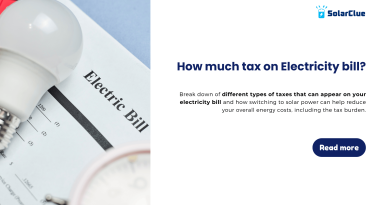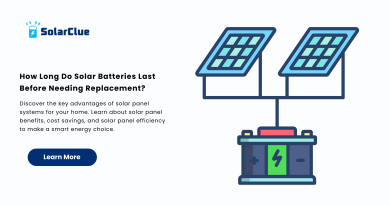How Much Electricity Does A Solar Panel Produce?
Solar panels are an efficient and sustainable way to generate electricity. Understanding how much energy a solar panel can produce is essential for maximizing their benefits. This guide explores solar panel wattage, factors affecting electricity production, and how to estimate solar energy generation for specific locations.
Table of Contents
- 1 Understanding Solar Panel Wattage
- 2 Factors Affecting Solar Panel Electricity Production
- 3 The Role of Peak Sun Hours
- 4 Understanding Energy Units
- 5 Calculating Potential Energy Production
- 6 Comparing Energy Output of Different Solar Panel Types
- 7 FAQs
- 7.1 1. What is the average efficiency of solar panels?
- 7.2 2. How do peak sun hours affect solar energy production?
- 7.3 3. Can solar panels generate electricity on cloudy days?
- 7.4 4. How does temperature impact solar panel performance?
- 7.5 5. How do I calculate the size of the solar panel system I need?
Understanding Solar Panel Wattage
What is Wattage?
Wattage (W) measures the rate of energy production or consumption. For solar panels, wattage indicates how much electricity a panel can generate under standard test conditions. Higher wattage means greater energy production.
Relation to Solar Panel Performance
The performance of a solar panel is directly related to its wattage. A 300-watt panel will produce more electricity than a 200-watt panel, assuming other factors like efficiency and sunlight intensity are constant.
Factors Affecting Solar Panel Electricity Production
Panel Efficiency
Efficiency is the percentage of sunlight that a solar panel can convert into usable electricity. Higher efficiency panels produce more electricity in a given amount of space.
Sunlight Intensity
Sunlight intensity varies based on location, weather, and time of year. Areas with more direct sunlight will see higher energy production from solar panels.
Temperature
Solar panels perform better in cooler temperatures. Higher temperatures can reduce the efficiency of solar panels, leading to lower energy production.
Panel Orientation
The orientation and tilt of solar panels affect how much sunlight they capture. Panels facing south in the Northern Hemisphere (north in the Southern Hemisphere) at an optimal tilt angle will produce the most electricity.
The Role of Peak Sun Hours
Peak sun hours refer to the number of hours per day when the sunlight is strong enough to generate maximum power from solar panels. This concept helps estimate the average daily energy production of a solar panel system.
Factors Influencing Solar Panel Efficiency
| Factor | Description |
|---|---|
| Panel Efficiency | The percentage of sunlight converted into usable electricity. Higher efficiency means more power. |
| Sunlight Intensity | The strength and duration of sunlight at a specific location. More sunlight equals more energy. |
| Temperature | Cooler temperatures improve performance, while high temperatures reduce efficiency. |
| Panel Orientation | Proper orientation and tilt maximize sunlight capture and energy production. |
By understanding these factors and calculations, you can estimate the energy output of solar panels for your specific location and needs, ensuring optimal performance and cost savings.
Understanding Energy Units
Watts (W)
A watt is a unit of power that measures the rate of energy conversion or transfer.
Kilowatts (kW)
A kilowatt equals 1,000 watts. It is a more practical unit for measuring the power output of solar panel systems.
Kilowatt-Hours (kWh)
A kilowatt-hour measures energy usage over time. It is the amount of energy produced or consumed by a 1-kilowatt system running for one hour.
Calculating Potential Energy Production
For a Home
1. Determine Daily Energy Consumption: Check your electricity bill to find your monthly kWh usage, then divide by 30 to find daily consumption.
2. Calculate System Size Needed: Divide your daily energy consumption by the average peak sun hours in your location.
3. Estimate Energy Production: Multiply the system size (in kW) by peak sun hours to estimate daily energy production.
Example:
- Daily consumption: 30 kWh
- Peak sun hours: 5 hours
- Required system size: 30 kWh / 5 hours = 6 kW
- Estimated daily production: 6 kW * 5 hours = 30 kWh
For a Business
The process is similar but scaled up based on the higher energy demands of a business. Larger systems and more precise calculations based on peak demand times may be needed.
Comparing Energy Output of Different Solar Panel Types
| Panel Type | Efficiency Range | Typical Wattage | Pros | Cons |
|---|---|---|---|---|
| Monocrystalline | 15-22% | 250-400 W | High efficiency, space-efficient | Higher cost |
| Polycrystalline | 13-18% | 200-350 W | Lower cost | Lower efficiency, larger area needed |
| Thin-Film | 10-12% | 100-300 W | Lightweight, flexible | Lowest efficiency, large area needed |
Here at SolarClue®, we offer a smart, practical, and “beautiful” solution. You will be answered for all the questions related to Solar.
We provide all kinds of brands that are the Best Solar panels in India.
If you are the one who is planning for the solar power system. Don’t hesitate to contact our team!
Looking forward to empowering you with solar energy, just like hundreds of our other clients!
FAQs
1. What is the average efficiency of solar panels?
Modern solar panels have efficiencies ranging from 15% to 22%, depending on the type and technology used.
2. How do peak sun hours affect solar energy production?
Peak sun hours help estimate the daily energy production of a solar panel system by indicating the number of hours per day when sunlight intensity is optimal for maximum power generation.
3. Can solar panels generate electricity on cloudy days?
Yes, solar panels can still produce electricity on cloudy days, but their output will be reduced compared to sunny conditions.
4. How does temperature impact solar panel performance?
Solar panels are less efficient at higher temperatures. Cooler temperatures generally improve performance and energy output.
5. How do I calculate the size of the solar panel system I need?
To calculate the system size, divide your daily energy consumption (in kWh) by the average peak sun hours in your location. This will give you the required system size in kilowatts (kW).




